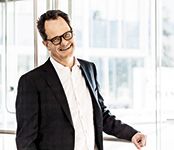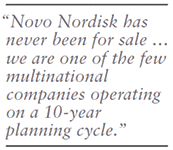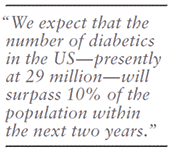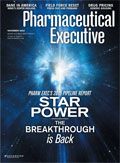Dane in America
Pharmaceutical Executive
Jesper Hoiland, Novo Nordisk's President for North America, assesses the challenges and opportunities during his first year at the helm of the diabetes franchise leader's biggest affiliate market.
Everyone knows that Novo Nordisk is a tightly focused enterprise neatly matched to a big disease footprint—diabetes, where it commands nearly 50% of the global insulin market. A critical—and less apparent—driver of the company's success has been its long journey to build a viable presence in the US, a market whose size and reach makes it a proving ground for any business with global aspirations. Prior to 2001, Novo Nordisk was just a bit player here, with annual sales below the $300 million mark. Paced by some risky investments to build a US sales force literally from scratch, the company raised that number tenfold in the years up to 2008, and then more than doubled it again after the introduction in 2009 of its breakthrough glucagon-like peptide-1 (GLP-1) analogue, Victoza. This year, Novo Nordisk's US sales are slated to surpass $7 billion, with Victoza alone racking up a 60%-plus share of the GLP-1 market.

To take a closer look at Novo Nordisk's blueprint for the US, Pharm Exec met last month with Senior Vice President for North America Jesper Hoiland. Hoiland, 54, a 27-year company veteran who assumed his post in August 2013, is the first native Dane to lead the US business. It's a distinction that Hoiland sees as an opportunity to create a broader cross-cultural perspective and promote better understanding of a complex—and often non-transparent—operating environment for medicines. In the following Q&A, Hoiland discusses his first year on the job at the company's regional headquarters in Princeton, including an unsettling initial encounter with the growing clout of pharmacy benefit manager (PBM) medicines gatekeepers; looming price wars; observations on the vital importance of stakeholder outreach in a transactional health system driven largely by relationships; all the advance planning required to unleash the promise of the eight to 10 new compounds Novo Nordisk hopes to commercialize by the end of the decade; and implementing what he sees as the three essential contributors to CEO leadership success: People. People—and People.
PE: You joined Novo Nordisk in 1987. What was your first assignment? How have the company's clinical and business practices changed over the past 27 years?
Hoiland: My first job as a young manager at Novo back in 1987 seems inconceivable today. The interesting part is that I was assigned to the US, at a time when we had virtually no presence here. Between Novo and Nordisk, which were still separate companies then, we had less than 75 people, including sales reps. Among other things, I was tasked to estimate the number of cattle Novo would need each year to fill the demand for human insulin, which was mostly extracted from cow glands. This depended, in turn, on accurate forecasts of the growth of the US diabetes market. Getting the right estimate was also important because in the 1980s the US dollar was highly volatile. All that seems fanciful now given the advances in both science and information.
Looking back over the years, our business practices have been affected most notably by information technology. In the 1980s, as the youngest manager on staff, I was good at adapting to the new data management tools coming on stream, which explains why I became the first person outside the finance department to be given a personal computer. I recall being asked by my supervisors to figure out what other uses Novo could find for it. Ironically, today I hardly use my desktop because I prefer to meet and talk to people directly. Personal interactions are the basis of my management style.

Not for sale
PE: Further to business practices, hasn't Novo Nordisk's longstanding status as having a foundation as its majority shareholder kept it remarkably stable over the years, particularly compared to the short-term business pressures that confront publicly held enterprises?
Hoiland: Our company history is unique. We began as two companies, Nordisk and Novo, founded in 1923 and 1925, respectively, led by Danish physician researchers and pharmacists with a passionate scientific interest in diabetes—a condition that, due to the discovery of the insulin hormone by two Canadian researchers, was then just emerging as a treatable chronic disease. The two new companies led the world in turning this discovery into a product with clinical—and commercial—applications. Ninety years later, and as a combined company since 1989, we are still the leader, not just in Europe, but globally. We are able to build on decades of work in progressing the treatment of diabetes, from the accessibility, safety, and stability of man-made insulin to innovations in therapeutic delivery devices as well as investments in diabetes control and prevention in diverse community settings—our products are now marketed in 180 countries.
The focus on diabetes was made possible by the decision of both companies to structure themselves as a foundation under Danish law, Nordisk in 1926 and Novo in 1951. This allowed profits to be plowed back into research and treatment activities rather than be subject to tax. Dr. Hans Christian Hagedorn, a co-founder of Nordisk and inventor of the first bulk manufacturing process for insulin derived from the bovine pancreas, put most of the company's early revenues into research, including founding the Steno Memorial Hospital, which exists to this day and has had a distinguished record over the years in treating more than half of the diabetic patients in Zeeland and Copenhagen. The Foundation was also the force behind our very early investments in the enzymes that trigger many metabolic processes, the understanding of which paved the way for the development of reliable, artificially derived sources of insulin. That sister company, Novozymes, is now the world's largest producer of enzymes for industrial and human uses; as with Novo Nordisk, the Foundation is the majority shareholder.
At present, more than 70% of votes are controlled by the Novo Nordisk Foundation. This gives management the ability to deflect two negative influences on proper business planning: M&A pressures driven by activist shareholders, whose only motive is scoring a run-up in the stock price; and financial reporting biased toward short-term quarterly results at the expense of long-term performance. Novo Nordisk has never been for sale, even though over the years some prominent competitors have tried to buy us. We are one of the few multinational companies operating on a 10-year planning cycle.
Status as a foundation also colors the approach to corporate responsibility, where we adhere to "triple bottom line" reporting, which includes financial, social, and environmental performance metrics. We put that in place back in 2004, when we were the first major pharmaceutical company to do so. The commitment also shows in our record on executive compensation, where we have one of the lowest differential in this industry between our CEO's pay package and the pay of workers on the shop floor.
It pays to wander
PE: Now that you are leading a transformed US organization for Novo Nordisk—it ranks today as the company's largest foreign operation—what lessons do you draw from that first assignment in the US market?
Hoiland: My initial training in sales gave me basic knowledge about the pharmaceutical business that I continue to apply today. I still count as one of my proudest achievements the diploma I received after completing an arduous six-week course to obtain certification as a sales rep. I had to pass that test in order to keep my job. But that was only the beginning. Working in the field, meeting customers, and reacting spontaneously to their tough questions, convinced me that success does not come from sitting in an ivory tower.
Since I arrived as head of North America in August 2013, I've spent most of my time out of the office. I make an effort to visit and mingle with the sales force, whose numbers I have increased by nearly a fifth in the past year. I am reaching out to pharmacy benefit managers, payers, physicians, and nurses. I ask every diabetes patient I meet for their perspective on treatment. To the extent I can, I try to dialogue with regulators. I make it a point to be a guest lecturer at business schools, which I believe are a great source of ideas as well as giving me a chance to meet the next generation of managers. Because the US market is changing so quickly, it is important to possess a holistic, 360 degree view of what forces are shaping that change, especially because most of it is taking place outside our own narrow segment of the health system. To that end, this month, Houston became the first US city to join Novo Nordisk's "Cities Changing Diabetes," a global partnership focused on diabetes lifestyle education and fighting the rise in urban diabetes.

PE: What else about your background has helped in the transition to your current role?
Hoiland: I've had extensive international exposure that gave me an inventory of best practices to spread through different country markets. Prior to my present position, I worked in various capacities in Canada, Belgium, France, and, finally, Australia, where I served as Novo Nordisk's General Manager. More recently, I've tackled strategy and coordination issues from HQ as head of Global Marketing as well as International Operations, which included P&L responsibility for country affiliates outside North America, Europe, and Japan. I spent upwards of 150 days a year traveling to more than 80 countries looking for organic market growth opportunities. It was my responsibility to share and translate what I learned with other affiliates. One principle I espoused during my international days: once Novo Nordisk makes a commitment to a country, we stay. We don't pull out. It can be hard to live up to this pledge. It has been more than difficult to keep our business going in Iraq. But we have.
Bad idea
PE:What is your view of the matrix organizational model of managing a global business around multiple product lines or therapeutic areas?
Hoiland: I lament the current fashion of downgrading the traditional country manager. When a company has multiple therapeutic area leads in each country, the country manager becomes little more than a concierge. This sows internal confusion, promotes conflict, and damages local reputation. How can a leader build effective relationships if you say one thing to staff and stakeholders, which can then be contradicted by another manager of equivalent status? Matrix organizations ruin good companies. We do not rely on the practice at Novo Nordisk; if we did, it would probably speed my path to retirement.
People make the product
PE: Is there a "golden rule" that you apply to leading a business?
Hoiland: Let me distill my basic philosophy into three principles. The first is the caliber of your people. I think human capital accounts for more than 50% of a company's success. The second is the image of the company. This reinforces the first principle, because a solid reputation attracts the best talent. The third principle rests on your products, which in our industry is linked to quality and safety as well as clinical relevance and performance for patients. It's simple: finding the right people and putting them in positions where they can do the most good for the organization is the objective that every business leader should achieve first, above all others.
Another asset of this approach is that it avoids the tendency to "stovepipe" decision-making. It is important to be flexible about local cultures—there is always going to be a different way of doing things in Japan than in Denmark. However, I am also learning that there are more similarities among countries today that make it easier to manage the differences. It used to be said that the US and Europe followed entirely different models of healthcare, with contrasting roles for the government and the markets; businesses had no choice to adjust. Consider, however, that today in Denmark one fifth of the population has opted to take out private insurance to pay for their healthcare. Doesn't that remind you of the US? At the same time, the Affordable Care Act is likely to yield to more centralized decision-making under government supervision, which suggests there are learnings that can be transferred to the US from Europe.
Overall, in the next 10 years, I see a trend toward a merging of the models for the delivery and financing of healthcare, at least in the mature markets. The role of managers like me is to encourage that connectivity and share our distinct perspective in spreading best practices. For example, diabetes is on the front line of chronic disease—and Novo Nordisk knows precisely how to manage the challenge efficiently, in multiple care settings.
PE: Having occupied the top line management position in North America for a little more than a year, what impressions do you have about the US pharmaceutical market?
Hoiland: The US alone accounts for more than a third of the global market for pharmaceuticals. No company with global aspirations can afford not to be active and engaged here. Up until the year 2000, Novo Nordisk was squarely in the position of aspirant; we reversed it through a combination of tenacity and focus that relied heavily on the talent of our people.

Many experts say the US market is unique. This is true, to an extent. The employer-paid insurance model is different. But the claim the US has "price elasticity" in the form of flexible free pricing is accurate only for the relatively small specialty/orphan drug segment. The reality is list prices don't reflect what is really happening in negotiations, where the net take-home price ends up being very different. And such negotiations are usually conducted in a manner that is not transparent. To make the point in lay terms, I cite the analogy of the price for a hotel room you see on the door after you check in. If you paid $250 at registration compared to the $500 posted in the room, you think that's a wonderful bargain. But even that price is not reflective of reality: if by chance you are a frequent guest of the hotel, then your price will be another 20% lower, or $200. Then there are the last-minute buyers with no reservation for a hotel room for the evening. If the room is still unreserved at noon time, then there will be a middle-man with a smart phone app that will be able to sell it to you for $100.
So is this $500 list price the actual cost for reserving the room for the night? Certainly not. What you have in the US is an elaborate, negotiated system of drug rebates calibrated on the negotiating circumstances of each party. Steep discounts from drugmakers are expected and built in to the system. Right now, you can say the process is not very clear or open and tends to reflect the unacknowledged preferences of the payer. But that is going to change in the next five years due to a combination of powerful new information processing technologies, government disclosure, and compliance mandates, as well as structural changes like the consolidation of purchaser and provider services and disincentives around fee-for-service. Patient power will be important, too, because as patients pay more out of pocket, their sensitivity to costs will increase.
PE: How are these market drivers shaping your strategic agenda for the US business?
Hoiland: The biggest response so far lies in the restructure of our US sales force. My first decision was to create a new setup that acknowledges the traditional rep/physician contact alone will not push our business forward. In anticipation of new products, we have significantly increased our numbers of reps, while at the same time training and directing them differently, to focus less on direct selling than providing interpretive analytics, logistics, and data retrieval services. Despite all the benefits of this new technology, I am also still convinced that "boots on the ground" makes a difference because of the vast differences you see on a geographic basis in the US; it's not a homogenous market, so you need reps who can accurately interpret the territory. We've added 350 reps to the sales force in the last year, precisely for that reason.
Of course, we are also making big investments to keep pace with the decision-making chain around access. Today, physicians are only one element in the customer base for our medicines, and their influence is declining. Instead, you have the federal government, through Medicare, Medicaid, the VA, and the DOD, plus employers, PBMs, and the new ACO model, as well as patient out of pocket. Every one of these stakeholders—I've identified up to 10—requires a distinct approach. I am involved in direct interface with each of them.
Specifically, we are addressing proactively the provisions of the Affordable Care Act to determine how our medicines can be better utilized in the battle against chronic conditions, which is the top category of health spending—yet the complexity of co-pay provisions in the law means that, for the average patient, drug coverage is less than optimal in managing their condition uninterrupted, for the long-term. We also see how high co-insurance rates are a burden for patients, even those of middle-income status; many in this group are effectively under-insured, which hurt access to our medicines.
Formulary fracas
PE: Payer consolidation allows PBMs to leverage formulary controls to limit access to therapies. Use of this "nuclear option" is growing. Specifically, how did you respond to the removal last year of your top products, Victoza and Novolog, from the Express Scripts list of formulary-approved medicines?
Hoiland: The decision was taken prior to my arrival in the US; there was no opportunity to walk it back. Obviously, we disagree with the action, especially the premise behind it. It has put a dent in US sales of Victoza, but we have recouped some share due to stepped up efforts to highlight the strong clinical profile of Victoza against all competing GLP-1 agonists—including the two products that replaced Victoza on the Express Scripts approved list—as well as its value in improving overall health outcomes for patients on therapy.
Our strategy going forward has been clear and unequivocal: we are not seeking a formulary relisting based on any price acceptable to Express Scripts. We believe we have a high quality medicine, the denial of access to which is bad for patients. Our contacts with the physician community reveal a large number of Victoza prescribers would have preferred a different result, a perspective we have shared with Express Scripts and other stakeholders. Personally, I wonder how much Express Scripts has benefited financially from the decision, as patients switch to less familiar alternatives. And our competitors have clearly had to expand their use of rebating in addition to obtaining their current approved position on the drug list.

PE: So Novo Nordisk does not intend to pursue, as others have done, reinstatement by conceding on price?
Hoiland: We prefer a different approach, one based on our clinical performance that has in turn increased Novo Nordisk's market capitalization to a level higher than many other big pharma players. We are aggressively defending our pricing as justifiable in the context of our products' overall clinical and economic value, to providers and patients. One action I am taking directly is to strengthen our outreach and relationships to cover all corners of the marketplace, to ensure this abrupt impasse with Express Scripts does not happen again. What we have now is, in my opinion, a "lose-lose" situation, when in fact there was always the potential for a "win-win," had we been able to build in more dialogue. True, it requires a lot of tenacity and persistence—but like anything worthwhile in life, it usually takes five no's to get to a yes.
Trumping with Tresiba
PE: You have the opportunity to set this stakeholder engagement approach in motion with a prospective FDA approval next year of your next generation, long-acting insulin, Tresiba, already in use in Europe.
Hoiland: We are confident that we can present a strong case for Tresiba as clinically superior to the current standard of care in diabetes control. Access to any breakthrough justifies some form of premium on price. Of course, that price is open to negotiation—and should be. But given the billion-dollar costs of new drug development, if you end up essentially giving your product away, then the result is an industry that will not survive as the main source of the next generation of innovations.
PE: How do patients figure in this equation?
Hoiland: The bottom line for all patients is having access to a useful medicine. There are many tactics we can use to achieve that, including the appropriate use of coupons and co-pay offsets. It is important that patients remain aware of the clinical differences among products in the same therapeutic class, and to have the option to continue with a drug that has treated their condition successfully. Offsets allow for a choice—and choice is very important to the patient mindset. In Denmark, we have a process where a maximum reimbursement is set for a medicine based on a detailed examination of health economics data. If the price is higher than this amount, the patient is responsible for the balance. And there is insurance available to help the patient to do just that. This is one of the more sensible approaches to creating more options for the patient. I sense it is a trend that will spread to other countries, including the US.
PE: Novo Nordisk has had some highly successful new product launches in the past few years. How do you assess the current launch environment in the US—are you meeting initial expectations with the new Levemir FlexTouch pen device?
Hoiland: We launched FlexTouch here on June 24. It represents a new, accurate, and accessible way for patients to administer their insulin. It's already a huge success in Canada and early figures here look very convincing. A strong start is important: in the old days, nine months of sales were required to assess a launch success; today, the verdict is in at six weeks. The device has had good feedback from patients and especially from physicians, whom we have been cultivating with great care and commitment ever since we introduced to the world our first pen device for insulin, NovoPen, back in 1986.
Insulin devices exemplify how difficult it can be to obtain market acceptance for a genuine innovation. That first NovoPen device experienced early acceptance everywhere except the US. The device represented an advance in the level of convenience for insulin patients, yet, surprisingly, in the world's most consumer oriented market, we were unable to fight reliance on the traditional vial and syringe. Why? Because we lacked inroads to the pharmacy practice: our small team of sales reps might garner "wows" from physicians but when we persuaded them to write prescriptions for the pen, pharmacists would simply substitute it with that vial and syringe. It was a product they were familiar with—and because there were some extra processes involved, they got paid more for it.
So we had to work very hard, over several decades, to overcome that resistance, largely by continuing to build on the pen concept to create products with such a formidable array of patient benefits the resistance disappeared. Our latest launch represents our fifth generation of durable pen devices, which can now store as many as 80 units of insulin in one convenient, long-use device. That's a doubling of our previous limit of 40 units. It represents a major advance in innovation for patients who need more than those 40 units—more than half of the US diabetic population.

(PHOTO: THINKSTOCK)
Disruptive threats
PE: Innovation can also be disruptive and threaten established enterprises that lose the capacity to anticipate market change. Have you considered what "shot out of the blue" might pose a serious threat to Novo Nordisk's leadership in diabetes?
Hoiland: We've been in this business for 90 years. We have demonstrated the capacity to adapt, over and over. Certainly we have to keep pace with scientific progress, particularly in areas like stem cells that can restore the ability of the pancreas to produce insulin. Researchers always say that we are ten years away from reaping the promise of stem cell research. However, Novo Nordisk is actively studying this area, and we are prepared to seize any clinical or commercial opportunities that lead from it. The other potential disruption is some change that attacks diabetes at its root, in terms of wellness, prevention, and lifestyle. Human nature is a formidable opponent—there is an innate tendency for us to eat more, to crave bad things, and to exercise less. Hence, if someone discovered a way to fight fat and get lean and mean with no effort expended, it might force us to shift from the current diabetes treatment model focused on insulin replacement. It will be interesting to see if recent research pointing to a relationship between artificial sweeteners and the metabolic syndrome that leads to type 2 diabetes will spur a reduction in their use—will people start drinking water again? Assuming you could find that magic bullet on lifestyle adjustment, I still think the biggest impact would be on adjacent businesses like food, organized sports, and entertainment. At present, there is little on the horizon to stop the inexorable rise in the incidence of diabetes. We expect that the number of diabetics in the US —presently at 29 million—will surpass 10% of the population within the next two years.
PE: What about the potential of inhalable insulin delivery?
Hoiland: There should be safe alternatives to injection, but ultimately the market and the patient community will decide its commercial potential. Needle phobia has been oversold as an issue in compliance; the bigger challenge was the stigma associated with the daily requirement to inject, but much of that has disappeared in the last two decades due to the consumer appeal of all these fancy new pen devices.

The test: Keeping patients happy
PE: As a final thought, how do you define success in your role leading North America two or three years from now?
Hoiland: The critical objective for me is to be able to say that, through our collective efforts, patients here in the US and Canada are being diagnosed early and are managing their condition well to achieve better glycemic control and good health. I am always asked about the competition: to be blunt, I don't care about our rivals for market share. They are mostly good products; I can't do much about them. My focus has to stay on what we do to make a difference to patients with diabetes—that's something I can influence. FDA approval and a strong launch for Tresiba will be critical to realizing this vision. And we are resolved to extend this commitment beyond diabetes, especially in adjacent product segments that include obesity, hormonal treatments, and blood disorders like haemophilia, where, like diabetes, we are a long-standing market leader. All told, we are working on eight to 10 new compounds in our core therapy areas that we hope to commercialize by the end of this decade. The US is going to be crucial to this effort.
In particular, the US will be a test of evolving approaches to treating obesity as a stand-alone condition. We passed a key hurdle with September's near-unanimous endorsement by a FDA advisory committee of Saxenda, our once-daily human GLP-1 analogue, as a new treatment for certain people with obesity. Assuming it is approved, this drug will require all of our stakeholder outreach skills to ensure its success. Obesity may be endemic in this country, but to many outside the medical profession it remains a social stigma associated with a lack of personal self-control. We as a society—not just us in industry—must work harder to place this condition in its proper clinical context.

William Looney is Pharmaceutical Executive's Editor-in-Chief. He can be reached at wlooney@advanstar.com.
Trump: 'Major Tariff' on Pharmaceuticals Coming Soon
Published: April 9th 2025 | Updated: April 9th 2025“We’re going to tariff our pharmaceuticals, and once we do that, they are going to come rushing back into our country," President Donald J. Trump said during a Tuesday night dinner in Washington.
The Misinformation Maze: Navigating Public Health in the Digital Age
March 11th 2025Jennifer Butler, chief commercial officer of Pleio, discusses misinformation's threat to public health, where patients are turning for trustworthy health information, the industry's pivot to peer-to-patient strategies to educate patients, and more.
Navigating Distrust: Pharma in the Age of Social Media
February 18th 2025Ian Baer, Founder and CEO of Sooth, discusses how the growing distrust in social media will impact industry marketing strategies and the relationships between pharmaceutical companies and the patients they aim to serve. He also explains dark social, how to combat misinformation, closing the trust gap, and more.
